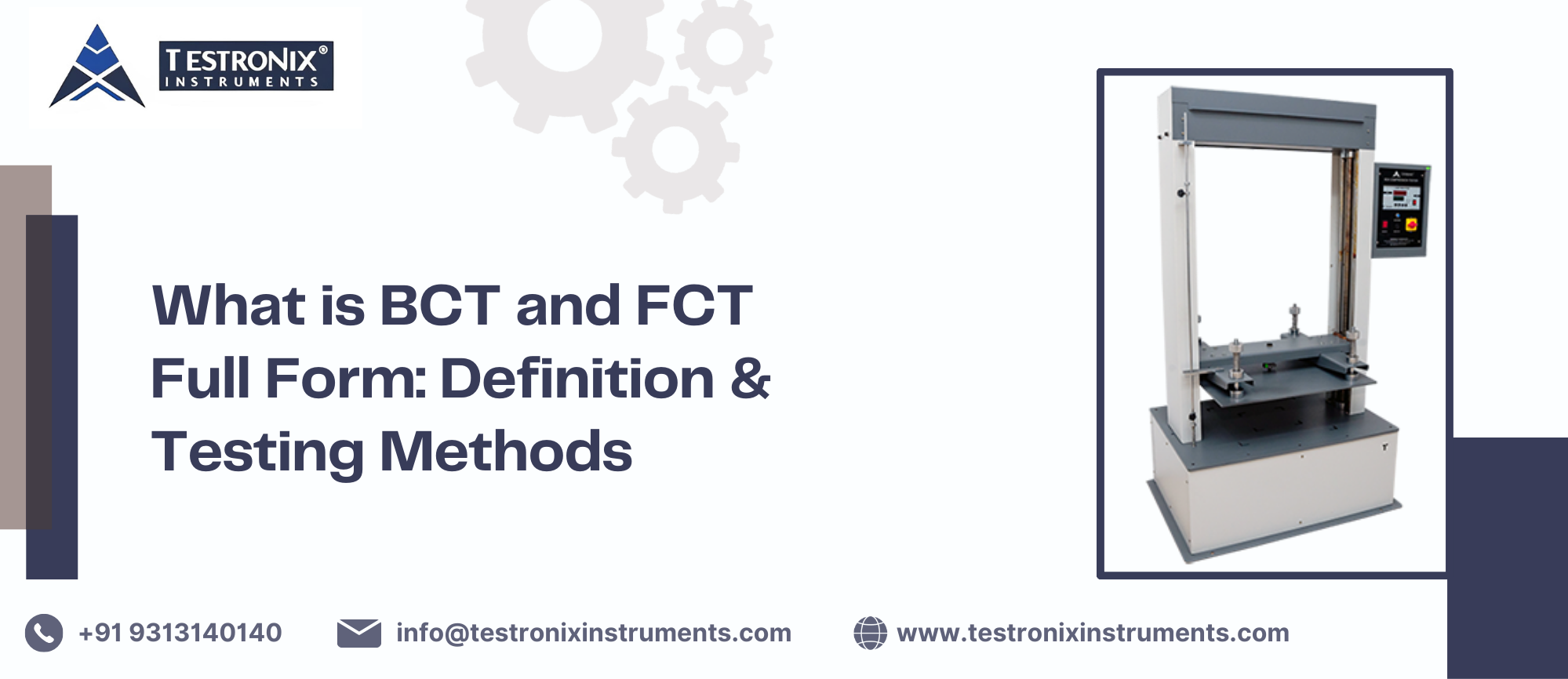Reviewed by Anurag Mishra (Sr. Technical Consultant)

BCT and FCT are important tests in manufacturing and packaging to check the strength and durability of packaging materials. BCT measures the strength of a corrugated box under pressure to ensure it can withstand stacking and transport.
FCT evaluates the material’s resistance to crushing, ensuring durability. Both tests help improve packaging quality and prevent product damage. Let’s explore more about these two tests for corrugated boxes and their working process.
The full form of BCT test is the Box Compression Test. It calculates the contractive strength of a corrugated box to check its ability to resist stacking and transportation pressures. It is also used to calculate the power of boxes produced in the factory.
This lab is maintained under strict conditions. The boxes tested during a BCT test are placed between two steel plates, pushing against each other with increasing pressure. At one moment, the box crashes, and this is the moment you know your BCT value.
The Box Compression Test (BCT) measures the strength of a corrugated box by applying uniform pressure until it deforms or collapses. The box is placed between two compression plates, and the maximum load it can withstand is recorded. Here is the step-by-step process –
Sustainability in packaging is becoming rapidly important. By improving box designs to use the least material while maintaining strength, companies can minimize waste and atmospheric impact. BCT helps in recognizing the correct balance between the material used and box presentation, encouraging sustainable packaging solutions.
Box Compression Tester can perform various functions for all attributes in the specified standard such as parametric test, display, memories, statistics, and print function; data processing function to achieve the accurate and statistical results of all the attributes directly; and automatic reset and fault diagnosis function and easy operation.
The following are the factors that affect the BCT results –
· Moisture inside the box and the environment.
· Handling of the box before the test.
· Flutes in the corrugated board. And many more.
The full form of FCT test is Flat Crush Test. It is a test that determines the quantity of force a corrugated board can resist when compressed perpendicular to its surface. The test is used to evaluate the structural honesty of a box and how well it can resist load. A flat crush test is organized to verify the resistance of corrugated paperboard to ridge crushing. This is a very important measurement.
When evaluating the amount of force and pressure applied during the printing process for corrugated boxes. In the flat crush test, a specimen of single-flute corrugated board is placed under pressure in a direction perpendicular to its surface.
The way the board resists this force gives insight into how it will perform during manufacturing and in actual use. The force must be applied strictly perpendicular to the specimen during the test.
The formula for the Flat Crush Test is:
Where Fmax is the maximum force applied, A is the area of the test piece, and the result is expressed as (kPa).
The Flat Crush Test measures the resistance of corrugated cardboard or fireboard to reduce loads. The test includes applying force perpendicular to the surface of a corrugated board specimen. The resistance of the board to the force indicates how it will perform during processing and use.
To perform the flat crush test, the equipment of the edge crush tester is altered and displaced with flat crushed plates. This makes the crush testing machine comprehensive. In the test, the corrugators of the sample are perpendicular to the corrugators.
The portable plate applies force on the sample. The force applied to deform the sample is verified and shown on the screen. In this test, the sample should be in a rounded shape. Knives and lever shears should not be used to cut specimens. The following are the steps to be followed to complete the test procedure –
In the world of packaging and product distribution, the Box Compression Test and Flat Crush Test are important tools to ensure the strength and accuracy of corrugated cardboard boxes. The Box Compression Test (BCT) helps in deciding the assembling power of a box, assuring it can resist external pressures for the time of transportation, shipping, and storage.
Flat Crush Test (FCT) evaluates the structural honesty of the ridge material, assuring the box maintains its shape and privacy level under load. Both tests are critical quality control measures in the packaging industry to ensure product safety and cost efficiency.